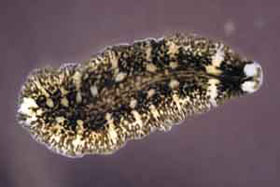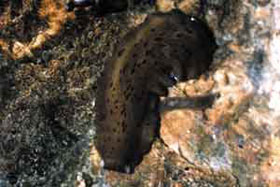Zoological excursions
Flatworms (Plathelminthes)
Another type of flatworms – Baicalobia variegate – inhabits the surf zone and deeper areas. This large worm is of oval shape 20 mm long and 7-8 mm wide. In the middle of the dark back there is a double dark stripe and two longitudinal rows of yellow-brown spots. Eyes are located on the sides of the anterior end of the body in a form of a horseshoe, each of which having 12-15 eyelets. Another species of planarians inhabiting the same areas is Bdellоcephala angarensis. This is a larger planarian (50 mm long and 10-15 mm wide). The body becomes wider at contraction. There are two large eyes on the head near the internal side of light spots. The colour of the back part of the body is brownish with irregular dark-brown spots. The peculiar feature of this planarian is that it forms wavy folds while moving.

Baicalobia variegata |

Bdellоcephala angarensis |

Rhimacephalus pulvinar |




